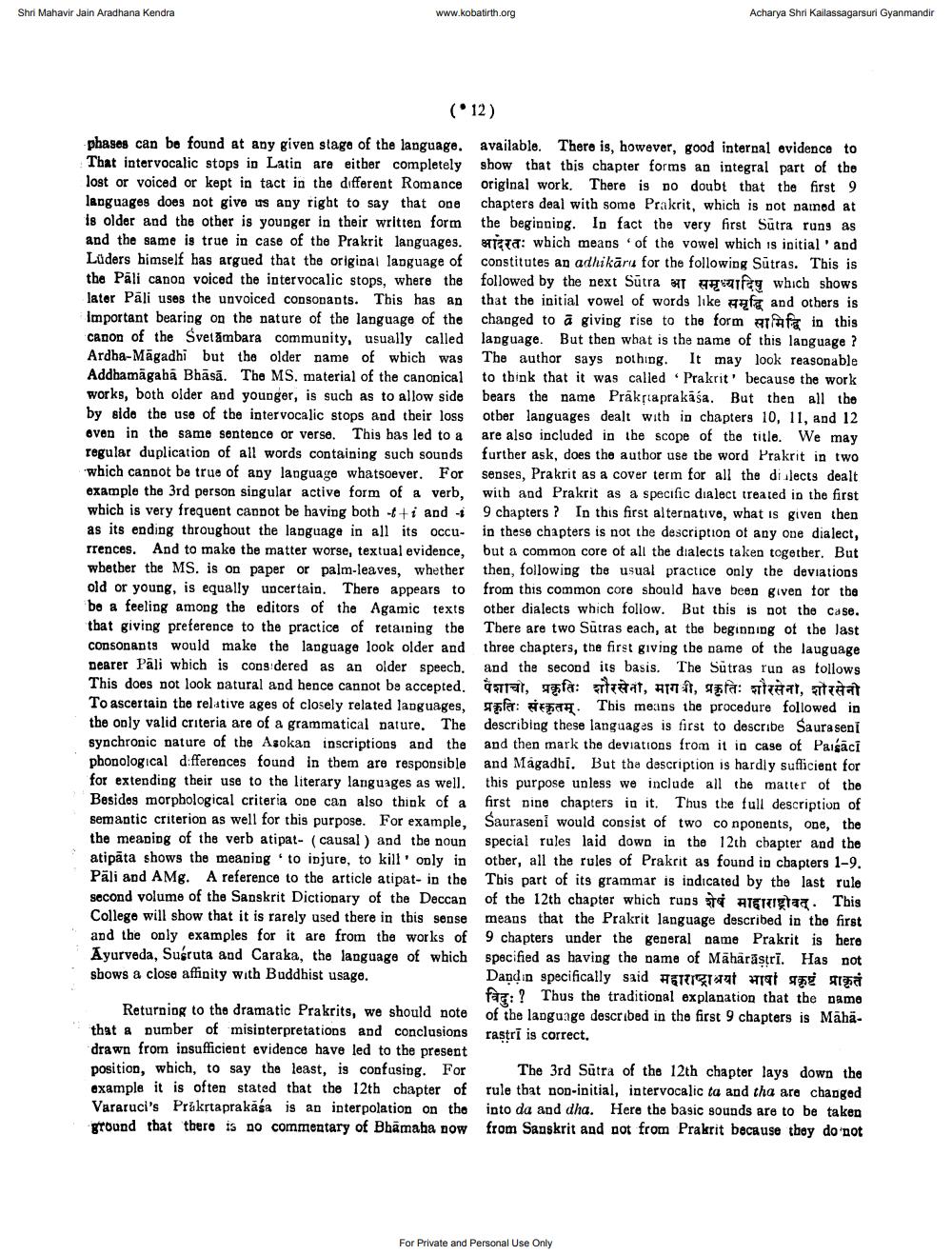________________
Shri Mahavir Jain Aradhana Kendra
www.kobatirth.org
Acharya Shri Kailassagarsuri Gyanmandir
(12)
phases can be found at any given stage of the language. available. There is, however, good internal evidence to That intervocalic stops in Latin are either completely show that this chapter forms an integral part of the lost or voiced or kept in tact in the different Romance original work. There is no doubt that the first 9 languages does not give us any right to say that one chapters deal with some Prakrit, which is not painod at is older and the other is younger in their written form the beginning. In fact the very first Sutra rung as and the same is true in case of the Prakrit languages. S ta: which means of the vowel which is initial' and Lüders himself has argued that the original language of constitutes an adhikāru for the following Sutras. This is the Pāli canon voiced the inter vocalic stops, where the followed by the next Sutra Tavafeg which shows later Pāli uses the unvoiced consonants. This has an that the initial vowel of words like aqfe and others is Important bearing on the nature of the language of the changed to a giving rise to the form a f in this canon of the Svetambara community, usually called language. But then what is the name of this language ? Ardha-Māgadhi but the older name of which was The author says nothing. It may look reasonable Addhamāgaba Bhāsā. The MS, material of the canonical to think that it was called Prakrit' because the work works, both older and younger, is such as to allow side bears the name Prakrtaprakāśa. But then all the by side the use of the intervocalic stops and their loss other languages dealt with in chapters 10, 11, and 12 oven in the same sentence or verse. This has led to a are also included in the scope of the title. We may regular duplication of all words containing such sounds further ask, does the author use the word Prakrit in two which cannot be true of any language whatsoever. For senses, Prakrit as a cover term for all the dialects dealt example the 3rd person singular active form of a verb, with and Prakrit as a specific dialect treated in the first which is very frequent cannot be having both ++i and 1 9 chapters? In this first alternative, what is given then as its ending throughout the language in all its occu- in these chapters is not the description of any one dialect, rrences. And to make the matter worse, textual evidence, but a common core of all the dialects taken together. But wbether the MS. is on paper or palm-leaves, whether then, following the usual practice only the deviations old or young, is equally uncertain. There appears to from this common core should have been given tor the be a feeling among the editors of the Agamic texts other dialects which follow. But this is not the case. that giving preference to the practice of retaining the There are two Sutras each, at the beginning of the last consonants would make the language look older and three chapters, the first giving the name of the lauguage Dearer Pāli which is cong dered as an older speech. and the second its basis. The Sutras run as tollows This does not look patural and hence cannot be accepted. Cat, fa: Theat, Art, anta: Teat, that To ascertain the relative ages of closely related languages, Tafa: . This means the procedure followed in the only valid criteria are of a grammatical nature. The describing these languages is first to describe Saura seni synchronic nature of the Asokan inscriptions and the and then mark the deviations from it in case of Paisāci phonological differences found in them are responsible and Magadbi. But the description is hardly sufficient for for extending their use to the literary languages as well. this purpose unless we include all the matter of the Besides morphological criteria one can also think of a first nine chapters in it. Thus the full description of semantic criterion as well for this purpose. For example, Sauraseni would consist of two conponents, one, the the meaning of the verb atipat- (causal ) and the noun special rules laid down in the 12th chapter and the atipāta shows the meaning to injure, to kill' only in other, all the rules of Prakrit as found in chapters 1-9. Päli and AMg. A reference to the article atipat- in the This part of its grammar is indicated by the last rule second volume of the Sanskrit Dictionary of the Deccan of the 12th chapter which runs staatgigta. This College will show that it is rarely used there in this sense means that the Prakrit language described in the first and the only examples for it are from the works of 9 chapters under the general name Prakrit is here Ayurveda, Susruta and Caraka, the language of which specified as having the name of Mahārāstri. Has not sbows a close affinity with Buddhist usage.
Dandin specifically said
that g iga
fag:? Thus the traditional explanation that the name Returning to the dramatic Prakrits, we should note of the language described in the first 9 chapters is Mähäthat a number of misinterpretations and conclusions rastri is correct. drawn from insufficient evidence have led to the present position, which, to say the least, is confusing. For The 3rd Sutra of the 12th chapter lays down the example it is often stated that the 12th chapter of rule that non-initial, intervocalic ta and tha are changed Vararuci's Prakrtaprakasa is an interpolation on the into da and dha. Here the basic sounds are to be taken ground that there is no commentary of Bhämaba now from Sanskrit and not from Prakrit because they do not
For Private and Personal Use Only




